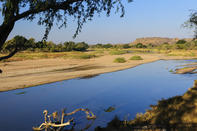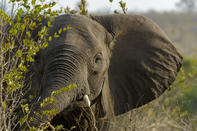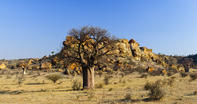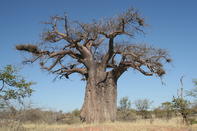Bushveld Igneous Complex
While it is hard to appreciate with anything but a keen geological eye, given that today it just looks like a vast stretch of rolling bushveld, the Bushveld Igneous Complex in Limpopo Province, South Africa is one of the world’s geological marvels. It’s what has remained of a vast intrusion of igneous rock that had been squeezed up from the earth's core into the mantel some two billion years ago - about half as long ago as the planet's birth.

The Bushveld Igneous Complex is essentially made up of tilted fragments of the original lens of rock, around what appears to be an ancient geological basin. What makes it so exceptional, however, is that it contains the world's largest reserves of platinum, palladium, osmium, iridium, rhodium and ruthenium, as well as vast deposits of iron, tin, chromium, titanium and vanadium. Just mentioning the Bushveld Igneous Complex to a mineralogist is enough to make him or her obscenely excited.
Great Limpopo Transfrontier Park
The core of this great wildlife conservation area is the Kruger National Park. The rest of the transfrontier park is made up of the private game reserves that cluster along the Kruger's western boundary, Gonarezhou National Park in Zimbabwe and Limpopo National Park in Mozambique.
This merging opens up vital migration corridors for the Kruger's burgeoning elephant population, allowing the elephants to move into new areas, which avoids overpopulation and culling. Creating migration corridors, not only for elephants but also for other large species, was the original dream of the Peace Parks Foundation that drives the creation of transfrontier parks in Africa.

Greater Mapungubwe Transfrontier Conservation Area
Until not so long ago, few South Africans even knew Mapungubwe existed, let alone that it was one of their national parks (previously known as Vhembe Dongola National Park) which is a pity because it incorporates some of the finest wild scenery on the subcontinent. The Greater Mapungubwe Transfrontier Conservation Area (TFCA), of which it is a part, stretches mainly along the Limpopo River and includes the Northern Tuli Conservation Area in Botswana and Tuli Circle Safari Area in Zimbabwe. The future of this park is now threatened by the granting of coal-mining rights to an Australian mining company on adjacent land.

Mopane Worms
The mopane worm, known as masonja or mashonzha in African dialects, is actually the larval form of the emperor moth, rather than a worm. These brightly coloured, thumb-plump caterpillars form an important source of protein in the rural areas where mopane trees grow, and are the most sought-after insect as far as many innovative humans are concerned. They seem to erupt on the mopane trees like a profusion of colourful flowers late each spring.
But you cannot simply help yourself. Each tree, or tract of trees, is 'owned' by a certain harvester, usually a local entrepreneur who sends out teams to collect them. They are sold fresh or dried, and tastes a lot like chicken! In early summer they mass on the trees in their millions, and then it's grub time in Limpopo.
Limpopo Baobabs

The largest baobab in South Africa when trunk, crown and height are considered together - is the Sagole Giant, east of Tshipise in the Limpopo Valley. It's got a trunk diameter of over 10 metres, crown diameter of over 38 metres and a height of some 22 metres. Intriguingly, in dry years the trunk diameter of a baobab can shrink.
Because baobabs are succulents and don't have growth rings they cannot be dated accurately, but recent thinking is that they are generally not as old as was previously reckoned. Ones like this colossus being maybe 2000 years old, others seldom more than 1000.